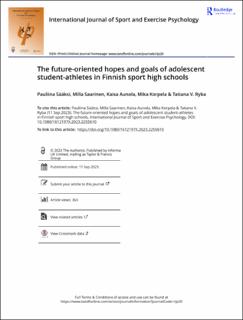| dc.contributor.author | Sääksi, Pauliina | |
| dc.contributor.author | Saarinen, Milla | |
| dc.contributor.author | Aunola, Kaisa | |
| dc.contributor.author | Korpela, Mika | |
| dc.contributor.author | Ryba, Tatiana V. | |
| dc.date.accessioned | 2024-03-18T16:37:48Z | |
| dc.date.available | 2024-03-18T16:37:48Z | |
| dc.date.created | 2023-09-25T14:11:58Z | |
| dc.date.issued | 2023 | |
| dc.identifier.citation | International Journal of Sport and Exercise Psychology. 2023, Artikkel 2255610. | en_US |
| dc.identifier.issn | 1612-197X | |
| dc.identifier.uri | https://hdl.handle.net/11250/3122964 | |
| dc.description | This is an Open Access article distributed under the terms of the Creative Commons Attribution License (http://creativecommons.org/licenses/by/4.0/), which permits unrestricted use, distribution, and reproduction in any medium, provided the original work is properly cited. The terms on which this article has been published allow the posting of the Accepted Manuscript in a repository by the author(s) or with their consent. | en_US |
| dc.description.abstract | As most young athletes do not end up making a living in sport, and professional athletic careers are relatively short, adolescent athletes need to think about and plan their future outside of sport. The present longitudinal study examined the future-oriented hopes and goals of adolescent student-athletes in Finland at the beginning and end of sport high school. Gender differences in these hopes and goals were also examined. The sample consisted of 381 student-athletes (51% females, 49% males) in the autumn of the first year of high school and 351 student-athletes (50% females, 50% males) in the spring of the third year, who filled in a questionnaire at both measurement points. A total of 11 goal categories consisting of 49 subcategories were identified using directed content analysis. Changes across time and gender differences in these hopes and goals were examined using the “N-1” chi-squared test. The results showed that sport-related hopes and goals were the most common at both measurement points. However, only 51% and 27% of the participants mentioned dual careers in their goals for the future at the beginning and end of high school, respectively. The female participants reported statistically significantly more goals related to education and a dual career and statistically significantly fewer goals related to sport than males. Further, male participants reported statistically significantly more often not knowing their future hopes and goals than females. | en_US |
| dc.language.iso | eng | en_US |
| dc.subject | dual career | en_US |
| dc.subject | future orientation | en_US |
| dc.subject | gender | en_US |
| dc.subject | hopes and goals | en_US |
| dc.subject | sports high school | en_US |
| dc.title | The future-oriented hopes and goals of adolescent student-athletes in Finnish sport high schools | en_US |
| dc.type | Peer reviewed | en_US |
| dc.type | Journal article | en_US |
| dc.description.version | publishedVersion | en_US |
| dc.rights.holder | © 2023 The Author(s) | en_US |
| dc.source.pagenumber | 18 | en_US |
| dc.source.journal | International Journal of Sport and Exercise Psychology | en_US |
| dc.identifier.doi | 10.1080/1612197X.2023.2255610 | |
| dc.identifier.cristin | 2178631 | |
| dc.description.localcode | Institutt for idrett og samfunnsvitenskap / Department of Sport and Social Sciences | en_US |
| dc.source.articlenumber | 2255610 | en_US |
| cristin.ispublished | true | |
| cristin.fulltext | original | |
| cristin.qualitycode | 1 | |
